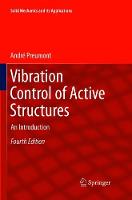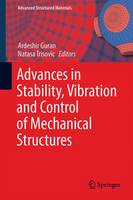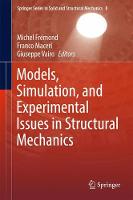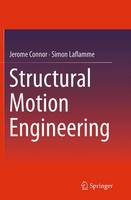Vibration Control of Active Structures
 -15%
portes grátis
-15%
portes grátis
Vibration Control of Active Structures
An Introduction
Preumont, Andre
Springer International Publishing AG
06/2019
518
Mole
Inglês
9783319891682
15 a 20 dias
1107
Descrição não disponível.
Preface to the third edition.- Preface to the second edition.- Preface to the first edition.- 1 Introduction.- 1.1 Active versus passive.- 1.2 Vibration suppression.- 1.3 Smart materials and structures.- 1.4 Control strategies.- 1.4.1 Feedback.- 1.4.2 Feedforward.- 1.5 The various steps of the design.- 1.6 Plant description, error and control budget.- 1.7 Readership and Organization of the book.- 1.8 References.- 1.9 Problems.- 2 Some concepts in structural dynamics.- 2.1 Introduction.- 2.2 Equation of motion of a discrete system.- 2.3 Vibration modes.- 2.4 Modal decomposition.- 2.4.1 Structure without rigid body modes.- 2.4.2 Dynamic degreesexibility matrix.- 2.4.3 Structure with rigid body modes.- 2.4.4 Example.- 2.5 Collocated control system.- 2.5.1 Transmission zeros and constrained system.- 2.6 Continuous structures.- 2.7 Guyan reduction.- 2.8 Craig-Bampton reduction.- 2.9 References.- 2.10 Problems.- 3 Electromagnetic and piezoelectric transducers.- 3.1 Introduction.- 3.2 Voice coil transducer.- 3.2.1 Proof-mass actuator.- 3.2.2 Geophone.- 3.3 General electromechanical transducer.- 3.3.1 Constitutive equations.- 3.3.2 Self-sensing.- 3.4 Reaction wheels and gyrostabilizers.- 3.5 Smart materials.- 3.6 Piezoelectric transducer.- 3.6.1 Constitutive relations of a discrete transducer.- 3.6.2 Interpretation of k2.- 3.6.3 Admittance of the piezoelectric transducer.- 3.7 References.- 3.8 Problems.- 4 Piezoelectric beam, plate and truss.- 4.1 Piezoelectric material.- 4.1.1 Constitutive relations.- 4.1.2 Coenergy density function.- 4.2 Hamilton's principle.- 4.3 Piezoelectric beam actuator.- 4.3.1 Hamilton's principle.- 4.3.2 Piezoelectric loads.- 4.4 Laminar sensor.- 4.4.1 Current and charge amplifiers.- 4.4.2 Distributed sensor output.- 4.4.3 Charge amplifier dynamics.- 4.5 Spatial modalfilters.- 4.5.1 Modal actuator.- 4.5.2 Modal sensor.- 4.6 Active beam with collocated actuator-sensor.- 4.6.1 Frequency response function.- 4.6.2 Pole-zero pattern.- 4.6.3 Modal truncation.- 4.7 Admittance of a beam with a piezoelectric patch.- 4.8 Piezoelectric laminate.- 4.8.1 Two dimensional constitutive equations.- 4.8.2 Kirchhoff theory.- 4.8.3 Stiffness matrix of a multi-layer elastic laminate.- 4.8.4 Multi-layer laminate with a piezoelectric layer.- 4.8.5 Equivalent piezoelectric loads.- 4.8.6 Sensor output.- 4.8.7 Beam model vs. plate model.- 4.8.8 Additional remarks.- 4.9 Active truss.- 4.9.1 Open-loop transfer function.- 4.9.2 Admittance function.- 4.10 Finite element formulation.- 4.11 References.- 4.12 Problems.- 5 Passive damping with piezoelectric transducers.- 5.1 Introduction.- 5.2 Resistive shunting.- 5.3 Inductive shunting.- 5.4 Switched shunt.- 5.4.1 Equivalent damping ratio.- 5.5 References.- 5.6 Problems.- 6 Collocated versus non-collocated control.- 6.1 Introduction.- 6.2 Pole-zero flipping.- 6.3 The two-mass problem.- 6.3.1 Collocated control.- 6.3.2 Non-collocated control.- 6.4 Notch filter.- 6.5 Effect of pole-zero flipping on the Bode plots.- 6.6 Nearly collocated control system.- 6.7 Non-collocated control systems.- 6.8 The role of damping.- 6.9 References.- 6.10 Problems ..- 7 Active damping with collocated system.- 7.1 Introduction.- 7.2 Lead control.- 7.3 Direct velocity feedback (DVF).- 7.4 Positive Position Feedback (PPF).- 7.5 Integral Force Feedback(IFF).- 7.6 Duality between the Lead and the IFF controllers.- 7.6.1 Root-locus of a single mode.- 7.6.2 Open-loop poles and zeros.- 7.7 Actuator and sensor dynamics.- 7.8 Decentralized control with collocated pairs.- 7.8.1 Cross talk.- 7.8.2 Force actuator and displacement sensor.- 7.8.3 Displacement actuator and force sensor.- 7.9 References.- 7.10 Problems.- 8 Vibration isolation.- 8.1 Introduction.- 8.2 Relaxation isolator.- 8.2.1 Electromagnetic realization.- 8.3 Active isolation.- 8.3.1 Sky-hook damper.- 8.3.2 Integral Force Feedback.- 8.4 Flexible body.- 8.4.1 Free-free beam with isolator.- 8.5 Payload isolation in spacecraft.- 8.5.1 Interaction isolator/attitude control.- 8.5.2 Gough-Stewart platform.- 8.6 Six-axis isolator.- 8.6.1 Relaxation isolator.- 8.6.2 Integral Force Feedback.- 8.6.3 Spherical joints, modal spread.- 8.7 Active vs. passive.- 8.8 Car suspension.- 8.9 References.- 8.10 Problems.- 9 State space approach.- 9.1 Introduction.- 9.2 State space description.- 9.2.1 Single degree of freedom oscillator.- 9.2.2 Flexible structure.- 9.2.3 Inverted pendulum.- 9.3 System transfer function.- 9.3.1 Poles and zeros.- 9.4 Pole placement by state feedback.- 9.4.1 Example: oscillator.- 9.5 Linear Quadratic Regulator.- 9.5.1 Symmetric root locus.- 9.5.2 Inverted pendulum.- 9.6 Observer design.- 9.7 Kalman Filter.- 9.7.1 Inverted pendulum.- 9.8 Reduced order observer.- 9.8.1 Oscillator.- 9.8.2 Inverted pendulum.- 9.9 Separation principle.- 9.10 Transfer function of the compensator.- 9.10.1 The two-mass problem.- 9.11 References.- 9.12 Problems.- 10 Analysis and synthesis in the frequency domain.- 10.1 Gain and phase margins.- 10.2 Nyquist criterion.- 10.2.1 Cauchy's principle.- 10.2.2 Nyquist stability criterion.- 10.3 Nichols chart.- 10.4 Feedback specification for SISO systems.- 10.4.1 Sensitivity.- 10.4.2 Tracking error.- 10.4.3 Performance specification.- 10.4.4 Unstructured uncertainty.- 10.4.5 Robust performance and robust stability.- 10.5 Bode gain-phase relationships.- 10.6 The Bode Ideal Cutoff.- 10.7 Non-minimum phase systems.- 10.8 Usual compensators.- 10.8.1 System type.- 10.8.2 Lead compensator.- 10.8.3 PI compensator.- 10.8.4 Lag compensator.- 10.8.5 PID compensator.- 10.9 Multivariable systems.- 10.9.1 Performance specification.- 10.9.2 Small gaintheorem.- 10.9.3 Stability robustness tests.- 10.9.4 Residual dynamics.- 10.10References.- 10.11Problems.- 11 Optimal control.- 11.1 Introduction.- 11.2 Quadratic integral.- 11.3 Deterministic LQR.- 11.4 Stochastic response to a white noise.- 11.4.1 Remark.- 11.5 Stochastic LQR.- 11.6 Asymptotic behavior of the closed-loop.- 11.7 Prescribed degree of stability.- 11.8 Gain and phase margins of the LQR.- 11.9 Full state observer.- 11.9.1 Covariance of the reconstruction error.- 11.10Kalman-Bucy Filter (KBF).- 11.11Linear Quadratic Gaussian (LQG).- 11.12Duality.- 11.13Spillover.- 11.13.1Spillover reduction.- 11.14Loop Transfer Recovery (LTR).- 11.15Integral control with state feedback.- 11.16Frequency shaping.- 11.16.1Frequency-shaped cost functionals.- 11.16.2Noise model ..- 11.17References.- 11.18Problems.- 12 Controllability and Observability.- 12.1 Introduction.- 12.1.1 Definitions.- 12.2 Controllability and observabilitymatrices.- 12.3 Examples.- 12.3.1 Cart with two inverted pendulums.- 12.3.2 Double inverted pendulum.- 12.3.3 Two d.o.f. oscillator.- 12.4 State transformation.- 12.4.1 Control canonical form.- 12.4.2 Left and right eigenvectors.- 12.4.3 Diagonal form.- 12.5 PBH test.- 12.6 Residues.- 12.7 Example.- 12.8 Sensitivity.- 12.9 Controllability and observability Gramians.- 12.10Internally balanced coordinates.- 12.11Model reduction.- 12.11.1Transfer equivalent realization.- 12.11.2Internally balanced realization.- 12.11.3Example.- 12.12References.- 12.13Problems.- 13 Stability.- 13.1 Introduction.- 13.1.1 Phase portrait.- 13.2 Linear systems.- 13.2.1 Routh-Hurwitz criterion.- 13.3 Lyapunov's direct method.- 13.3.1 Introductory example.- 13.3.2 Stability theorem.- 13.3.3 Asymptotic stability theorem.- 13.3.4 Lasalle's theorem.- 13.3.5 Geometric interpretation.- 13.3.6 Instability theorem.- 13.4 Lyapunov functions for linear systems.- 13.5 Lyapunov's indirect method ..- 13.6 An application to controller design.- 13.7 Energy absorbing controls.- 13.8 References.- 13.9 Problems.- 14 Applications.- 14.1 Digital implementation.- 14.1.1 Sampling, aliasing and prefiltering.- 14.1.2 Zero-order hold, computational delay.- 14.1.3 Quantization.- 14.1.4 Discretization of a continuous controller.- 14.2 Active damping of a truss structure.- 14.2.1 Actuator placement.- 14.2.2 Implementation, experimental results.- 14.3 Active damping generic interface.- 14.3.1 Active damping.- 14.3.2 Experiment.- 14.3.3 Pointing and position control.- 14.4 Active damping of a plate.- 14.4.1 Control design.- 14.5 Active damping of a stiff beam.- 14.5.1 System design.- 14.6 The HAC/LAC strategy.- 14.6.1 Wide-band position control.- 14.6.2 Compensator design.- 14.6.3 Results.- 14.7 Vibroacoustics: Volume displacement sensors.- 14.7.1 QWSIS sensor.- 14.7.2 Discrete array sensor.- 14.7.3 Spatial aliasing.- 14.7.4 Distributed sensor.- 14.8 References.- 14.9 Problems.- 5 Tendon Control of Cable Structures.- 15.1 Introduction.- 15.2 Tendon control of strings and cables.- 15.3 Active damping strategy.- 15.4 Basic Experiment.- 15.5 Linear theory of decentralized active damping.- 15.6 Guyed truss experiment.- 15.7 Micro Precision Interferometer testbed.- 15.8 Free floating truss experiment.- 15.9 Application to cable-stayed bridges.- 15.10Laboratory experiment.- 15.11Control of parametric resonance.- 15.12Large scale experiment.- 15.13 References.- 16 Active Control of Large Telescopes.- 16.1 Introduction.- 16.2 Adaptive optics.- 16.3 Active optics.- 16.3.1 Monolithic primary mirror.- 16.3.2 Segmented primary mirror.- 16.4 SVD controller.- 16.4.1 Loop shaping of the SVD controller.- 16.5 Dynamics of a segmented mirror.- 16.6 Control-structure interaction.- 16.6.1 Multiplicative uncertainty.- 16.6.2 Additive uncertainty.- 16.6.3 Discussion.- 16.7 References.- 17 Semi-active control.- 17.1 Introduction.- 17.2 Magneto-rheological fluids.- 17.3 MR devices.- 17.4 Semi-active suspension.- 17.4.1 Semi-active devices.- 17.5 Narrow-band disturbance.- 17.5.1 Quarter-car semi-active suspension.- 17.6 References.- 17.7 Problems.- Bibliography.- Index.
Este título pertence ao(s) assunto(s) indicados(s). Para ver outros títulos clique no assunto desejado.
active structures;actuators;optimal control;structural dynamics;structural mechanics;vibration control textbook;Texty award
Preface to the third edition.- Preface to the second edition.- Preface to the first edition.- 1 Introduction.- 1.1 Active versus passive.- 1.2 Vibration suppression.- 1.3 Smart materials and structures.- 1.4 Control strategies.- 1.4.1 Feedback.- 1.4.2 Feedforward.- 1.5 The various steps of the design.- 1.6 Plant description, error and control budget.- 1.7 Readership and Organization of the book.- 1.8 References.- 1.9 Problems.- 2 Some concepts in structural dynamics.- 2.1 Introduction.- 2.2 Equation of motion of a discrete system.- 2.3 Vibration modes.- 2.4 Modal decomposition.- 2.4.1 Structure without rigid body modes.- 2.4.2 Dynamic degreesexibility matrix.- 2.4.3 Structure with rigid body modes.- 2.4.4 Example.- 2.5 Collocated control system.- 2.5.1 Transmission zeros and constrained system.- 2.6 Continuous structures.- 2.7 Guyan reduction.- 2.8 Craig-Bampton reduction.- 2.9 References.- 2.10 Problems.- 3 Electromagnetic and piezoelectric transducers.- 3.1 Introduction.- 3.2 Voice coil transducer.- 3.2.1 Proof-mass actuator.- 3.2.2 Geophone.- 3.3 General electromechanical transducer.- 3.3.1 Constitutive equations.- 3.3.2 Self-sensing.- 3.4 Reaction wheels and gyrostabilizers.- 3.5 Smart materials.- 3.6 Piezoelectric transducer.- 3.6.1 Constitutive relations of a discrete transducer.- 3.6.2 Interpretation of k2.- 3.6.3 Admittance of the piezoelectric transducer.- 3.7 References.- 3.8 Problems.- 4 Piezoelectric beam, plate and truss.- 4.1 Piezoelectric material.- 4.1.1 Constitutive relations.- 4.1.2 Coenergy density function.- 4.2 Hamilton's principle.- 4.3 Piezoelectric beam actuator.- 4.3.1 Hamilton's principle.- 4.3.2 Piezoelectric loads.- 4.4 Laminar sensor.- 4.4.1 Current and charge amplifiers.- 4.4.2 Distributed sensor output.- 4.4.3 Charge amplifier dynamics.- 4.5 Spatial modalfilters.- 4.5.1 Modal actuator.- 4.5.2 Modal sensor.- 4.6 Active beam with collocated actuator-sensor.- 4.6.1 Frequency response function.- 4.6.2 Pole-zero pattern.- 4.6.3 Modal truncation.- 4.7 Admittance of a beam with a piezoelectric patch.- 4.8 Piezoelectric laminate.- 4.8.1 Two dimensional constitutive equations.- 4.8.2 Kirchhoff theory.- 4.8.3 Stiffness matrix of a multi-layer elastic laminate.- 4.8.4 Multi-layer laminate with a piezoelectric layer.- 4.8.5 Equivalent piezoelectric loads.- 4.8.6 Sensor output.- 4.8.7 Beam model vs. plate model.- 4.8.8 Additional remarks.- 4.9 Active truss.- 4.9.1 Open-loop transfer function.- 4.9.2 Admittance function.- 4.10 Finite element formulation.- 4.11 References.- 4.12 Problems.- 5 Passive damping with piezoelectric transducers.- 5.1 Introduction.- 5.2 Resistive shunting.- 5.3 Inductive shunting.- 5.4 Switched shunt.- 5.4.1 Equivalent damping ratio.- 5.5 References.- 5.6 Problems.- 6 Collocated versus non-collocated control.- 6.1 Introduction.- 6.2 Pole-zero flipping.- 6.3 The two-mass problem.- 6.3.1 Collocated control.- 6.3.2 Non-collocated control.- 6.4 Notch filter.- 6.5 Effect of pole-zero flipping on the Bode plots.- 6.6 Nearly collocated control system.- 6.7 Non-collocated control systems.- 6.8 The role of damping.- 6.9 References.- 6.10 Problems ..- 7 Active damping with collocated system.- 7.1 Introduction.- 7.2 Lead control.- 7.3 Direct velocity feedback (DVF).- 7.4 Positive Position Feedback (PPF).- 7.5 Integral Force Feedback(IFF).- 7.6 Duality between the Lead and the IFF controllers.- 7.6.1 Root-locus of a single mode.- 7.6.2 Open-loop poles and zeros.- 7.7 Actuator and sensor dynamics.- 7.8 Decentralized control with collocated pairs.- 7.8.1 Cross talk.- 7.8.2 Force actuator and displacement sensor.- 7.8.3 Displacement actuator and force sensor.- 7.9 References.- 7.10 Problems.- 8 Vibration isolation.- 8.1 Introduction.- 8.2 Relaxation isolator.- 8.2.1 Electromagnetic realization.- 8.3 Active isolation.- 8.3.1 Sky-hook damper.- 8.3.2 Integral Force Feedback.- 8.4 Flexible body.- 8.4.1 Free-free beam with isolator.- 8.5 Payload isolation in spacecraft.- 8.5.1 Interaction isolator/attitude control.- 8.5.2 Gough-Stewart platform.- 8.6 Six-axis isolator.- 8.6.1 Relaxation isolator.- 8.6.2 Integral Force Feedback.- 8.6.3 Spherical joints, modal spread.- 8.7 Active vs. passive.- 8.8 Car suspension.- 8.9 References.- 8.10 Problems.- 9 State space approach.- 9.1 Introduction.- 9.2 State space description.- 9.2.1 Single degree of freedom oscillator.- 9.2.2 Flexible structure.- 9.2.3 Inverted pendulum.- 9.3 System transfer function.- 9.3.1 Poles and zeros.- 9.4 Pole placement by state feedback.- 9.4.1 Example: oscillator.- 9.5 Linear Quadratic Regulator.- 9.5.1 Symmetric root locus.- 9.5.2 Inverted pendulum.- 9.6 Observer design.- 9.7 Kalman Filter.- 9.7.1 Inverted pendulum.- 9.8 Reduced order observer.- 9.8.1 Oscillator.- 9.8.2 Inverted pendulum.- 9.9 Separation principle.- 9.10 Transfer function of the compensator.- 9.10.1 The two-mass problem.- 9.11 References.- 9.12 Problems.- 10 Analysis and synthesis in the frequency domain.- 10.1 Gain and phase margins.- 10.2 Nyquist criterion.- 10.2.1 Cauchy's principle.- 10.2.2 Nyquist stability criterion.- 10.3 Nichols chart.- 10.4 Feedback specification for SISO systems.- 10.4.1 Sensitivity.- 10.4.2 Tracking error.- 10.4.3 Performance specification.- 10.4.4 Unstructured uncertainty.- 10.4.5 Robust performance and robust stability.- 10.5 Bode gain-phase relationships.- 10.6 The Bode Ideal Cutoff.- 10.7 Non-minimum phase systems.- 10.8 Usual compensators.- 10.8.1 System type.- 10.8.2 Lead compensator.- 10.8.3 PI compensator.- 10.8.4 Lag compensator.- 10.8.5 PID compensator.- 10.9 Multivariable systems.- 10.9.1 Performance specification.- 10.9.2 Small gaintheorem.- 10.9.3 Stability robustness tests.- 10.9.4 Residual dynamics.- 10.10References.- 10.11Problems.- 11 Optimal control.- 11.1 Introduction.- 11.2 Quadratic integral.- 11.3 Deterministic LQR.- 11.4 Stochastic response to a white noise.- 11.4.1 Remark.- 11.5 Stochastic LQR.- 11.6 Asymptotic behavior of the closed-loop.- 11.7 Prescribed degree of stability.- 11.8 Gain and phase margins of the LQR.- 11.9 Full state observer.- 11.9.1 Covariance of the reconstruction error.- 11.10Kalman-Bucy Filter (KBF).- 11.11Linear Quadratic Gaussian (LQG).- 11.12Duality.- 11.13Spillover.- 11.13.1Spillover reduction.- 11.14Loop Transfer Recovery (LTR).- 11.15Integral control with state feedback.- 11.16Frequency shaping.- 11.16.1Frequency-shaped cost functionals.- 11.16.2Noise model ..- 11.17References.- 11.18Problems.- 12 Controllability and Observability.- 12.1 Introduction.- 12.1.1 Definitions.- 12.2 Controllability and observabilitymatrices.- 12.3 Examples.- 12.3.1 Cart with two inverted pendulums.- 12.3.2 Double inverted pendulum.- 12.3.3 Two d.o.f. oscillator.- 12.4 State transformation.- 12.4.1 Control canonical form.- 12.4.2 Left and right eigenvectors.- 12.4.3 Diagonal form.- 12.5 PBH test.- 12.6 Residues.- 12.7 Example.- 12.8 Sensitivity.- 12.9 Controllability and observability Gramians.- 12.10Internally balanced coordinates.- 12.11Model reduction.- 12.11.1Transfer equivalent realization.- 12.11.2Internally balanced realization.- 12.11.3Example.- 12.12References.- 12.13Problems.- 13 Stability.- 13.1 Introduction.- 13.1.1 Phase portrait.- 13.2 Linear systems.- 13.2.1 Routh-Hurwitz criterion.- 13.3 Lyapunov's direct method.- 13.3.1 Introductory example.- 13.3.2 Stability theorem.- 13.3.3 Asymptotic stability theorem.- 13.3.4 Lasalle's theorem.- 13.3.5 Geometric interpretation.- 13.3.6 Instability theorem.- 13.4 Lyapunov functions for linear systems.- 13.5 Lyapunov's indirect method ..- 13.6 An application to controller design.- 13.7 Energy absorbing controls.- 13.8 References.- 13.9 Problems.- 14 Applications.- 14.1 Digital implementation.- 14.1.1 Sampling, aliasing and prefiltering.- 14.1.2 Zero-order hold, computational delay.- 14.1.3 Quantization.- 14.1.4 Discretization of a continuous controller.- 14.2 Active damping of a truss structure.- 14.2.1 Actuator placement.- 14.2.2 Implementation, experimental results.- 14.3 Active damping generic interface.- 14.3.1 Active damping.- 14.3.2 Experiment.- 14.3.3 Pointing and position control.- 14.4 Active damping of a plate.- 14.4.1 Control design.- 14.5 Active damping of a stiff beam.- 14.5.1 System design.- 14.6 The HAC/LAC strategy.- 14.6.1 Wide-band position control.- 14.6.2 Compensator design.- 14.6.3 Results.- 14.7 Vibroacoustics: Volume displacement sensors.- 14.7.1 QWSIS sensor.- 14.7.2 Discrete array sensor.- 14.7.3 Spatial aliasing.- 14.7.4 Distributed sensor.- 14.8 References.- 14.9 Problems.- 5 Tendon Control of Cable Structures.- 15.1 Introduction.- 15.2 Tendon control of strings and cables.- 15.3 Active damping strategy.- 15.4 Basic Experiment.- 15.5 Linear theory of decentralized active damping.- 15.6 Guyed truss experiment.- 15.7 Micro Precision Interferometer testbed.- 15.8 Free floating truss experiment.- 15.9 Application to cable-stayed bridges.- 15.10Laboratory experiment.- 15.11Control of parametric resonance.- 15.12Large scale experiment.- 15.13 References.- 16 Active Control of Large Telescopes.- 16.1 Introduction.- 16.2 Adaptive optics.- 16.3 Active optics.- 16.3.1 Monolithic primary mirror.- 16.3.2 Segmented primary mirror.- 16.4 SVD controller.- 16.4.1 Loop shaping of the SVD controller.- 16.5 Dynamics of a segmented mirror.- 16.6 Control-structure interaction.- 16.6.1 Multiplicative uncertainty.- 16.6.2 Additive uncertainty.- 16.6.3 Discussion.- 16.7 References.- 17 Semi-active control.- 17.1 Introduction.- 17.2 Magneto-rheological fluids.- 17.3 MR devices.- 17.4 Semi-active suspension.- 17.4.1 Semi-active devices.- 17.5 Narrow-band disturbance.- 17.5.1 Quarter-car semi-active suspension.- 17.6 References.- 17.7 Problems.- Bibliography.- Index.
Este título pertence ao(s) assunto(s) indicados(s). Para ver outros títulos clique no assunto desejado.







